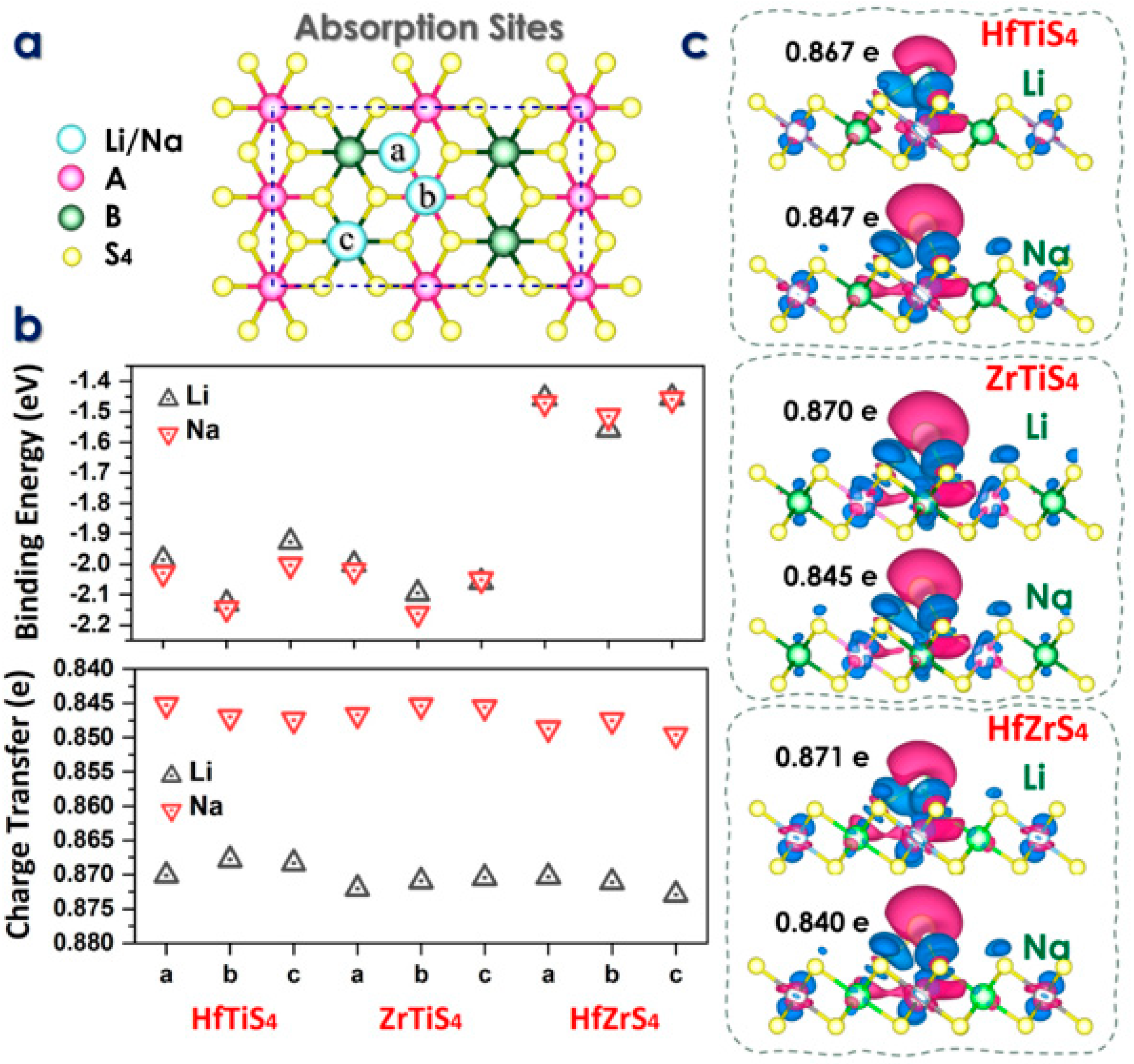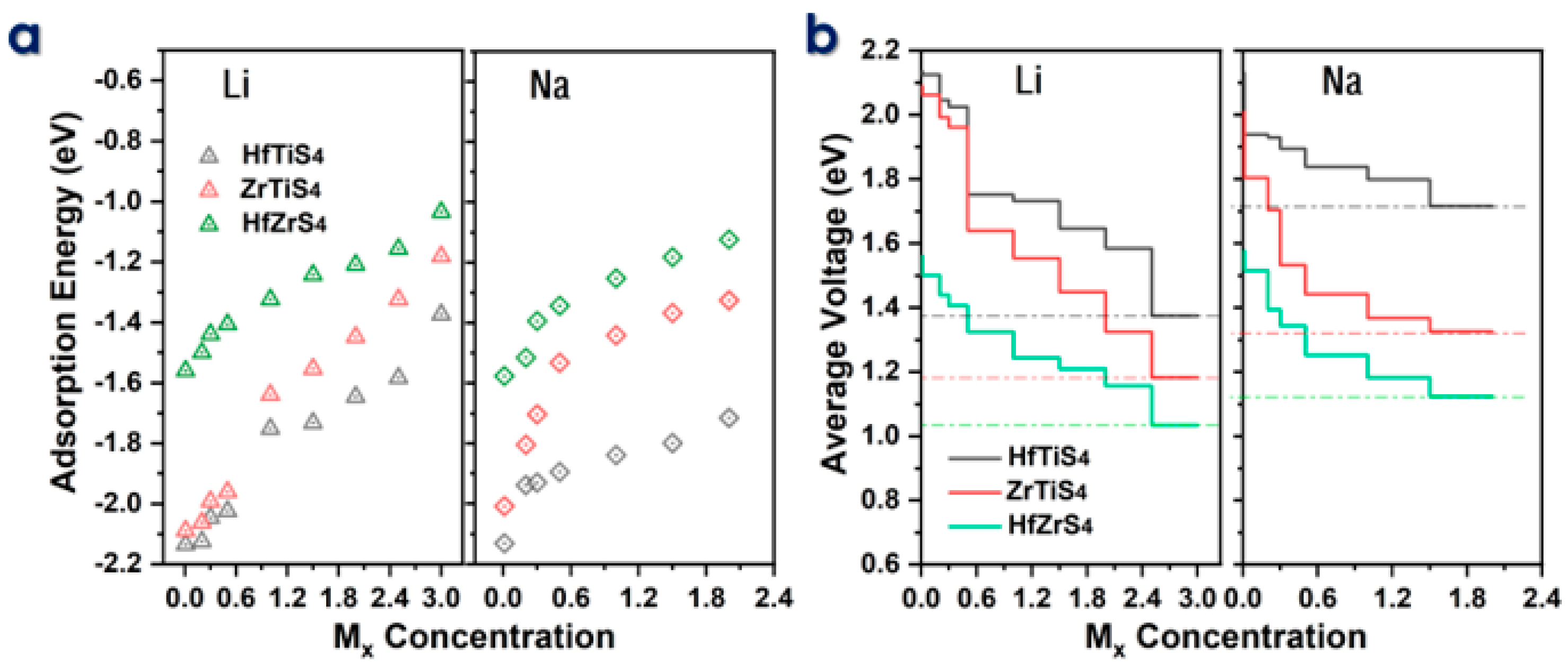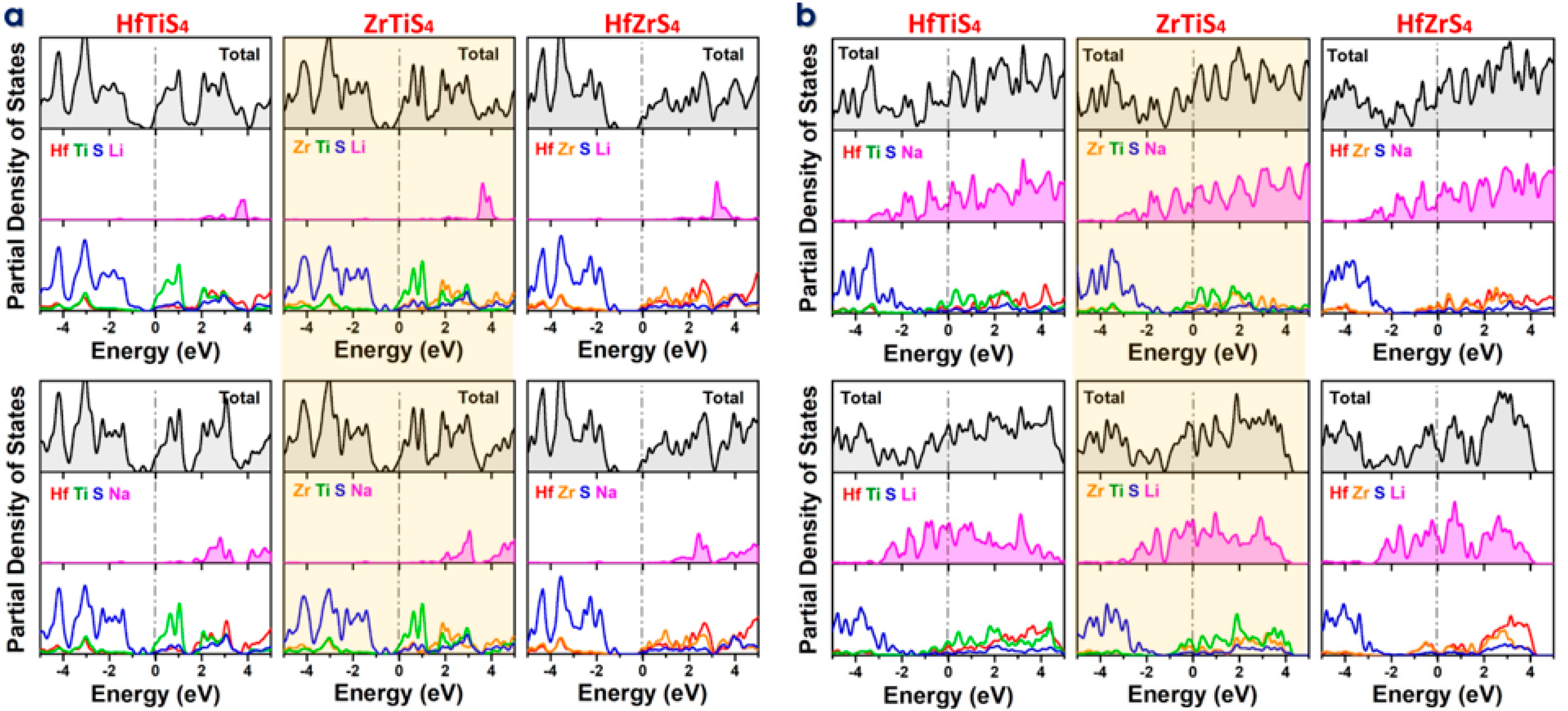Two-Dimensional ABS4 (A and B = Zr, Hf, and Ti) as Promising Anode for Li and Na-Ion Batteries
Abstract
1. Introduction
2. Computational Methods
3. Results and Discussion
4. Conclusions
Supplementary Materials
Author Contributions
Funding
Institutional Review Board Statement
Informed Consent Statement
Data Availability Statement
Conflicts of Interest
References
- Tarascon, J.-M.; Armand, M. Issues and challenges facing rechargeable lithium batteries. Nature 2001, 414, 359–367. [Google Scholar] [CrossRef] [PubMed]
- Arico, A.S.; Bruce, P.; Scrosati, B.; Tarascon, J.-M.; Van Schalkwijk, W. Nanostructured materials for advanced energy conversion and storage devices. Nat. Mater. 2005, 4, 366–377. [Google Scholar] [CrossRef]
- Kang, B.; Ceder, G. Battery materials for ultrafast charging and discharging. Nature 2009, 458, 190–193. [Google Scholar] [CrossRef]
- Yoo, E.; Kim, J.; Hosono, E.; Zhou, H.-S.; Kudo, T.; Honma, I. Large Reversible Li Storage of Graphene Nanosheet Families for Use in Rechargeable Lithium Ion Batteries. Nano Lett. 2008, 8, 2277–2282. [Google Scholar] [CrossRef]
- Ahmad, M.; Chen, J.; Liu, J.; Zhang, Y.; Song, Z.; Afzal, S.; Raza, W.; Zeb, L.; Mehmood, A.; Hussain, A. Metal-organic framework-based single-atom electro-/photocatalysts: Synthesis, energy applications, and opportunities. Carbon Energy 2024, 6, e382. [Google Scholar] [CrossRef]
- Chen, H.; Cong, T.N.; Yang, W.; Tan, C.; Li, Y.; Ding, Y. Progress in electrical energy storage system: A critical review. Prog. Nat. Sci. 2009, 19, 291–312. [Google Scholar] [CrossRef]
- Wang, Z.; Cai, J.; Han, Y.; Han, T.; Chen, A.; Ye, S.; Liu, J.; Li, J. Computational screening of spinel structure cathodes for Li-ion battery with low expansion and rapid ion kinetics. Comput. Mater. Sci. 2022, 204, 111187. [Google Scholar] [CrossRef]
- Idrees, M.; Batool, S.; Din, M.A.U.; Javed, M.S.; Ahmed, S.; Chen, Z. Material-structure-property integrated additive manufacturing of batteries. Nano Energy 2023, 109, 108247. [Google Scholar] [CrossRef]
- Bertaglia, T.; Costa, C.M.; Lanceros-Méndez, S.; Crespilho, F.N. Eco-friendly, sustainable, and safe energy storage: A nature-inspired materials paradigm shift. Mater. Adv. 2024, 5, 7534–7547. [Google Scholar] [CrossRef]
- Sharma, A.; Sharma, R.; Thakur, R.C.; Singh, L. An overview of deep eutectic solvents: Alternative for organic electrolytes, aqueous systems & ionic liquids for electrochemical energy storage. J. Energy Chem. 2023, 82, 592–626. [Google Scholar] [CrossRef]
- Rehman, W.U.; Jiang, Z.; Qu, Z.; Ahmed, S.; Ghani, A.; Xu, Y. Highly crystalline Prussian blue cubes filled with tin oxide as anode materials for lithium-ion batteries. Appl. Surf. Sci. 2022, 604, 154533. [Google Scholar] [CrossRef]
- Tantis, I.; Talande, S.; Tzitzios, V.; Basina, G.; Shrivastav, V.; Bakandritsos, A.; Zboril, R. Non-van der Waals 2D Materials for Electrochemical Energy Storage. Adv. Funct. Mater. 2023, 33, 2209360. [Google Scholar] [CrossRef]
- Zhou, J.; Lu, X.; Yu, M. Structure engineering of van der Waals layered transition metal-containing compounds for aqueous energy storage. Mater. Chem. Front. 2021, 5, 2996–3020. [Google Scholar] [CrossRef]
- Li, Y.; Yan, H.; Xu, B.; Zhen, L.; Xu, C.Y. Electrochemical intercalation in atomically thin van der Waals materials for structural phase transition and device applications. Adv. Mater. 2021, 33, 2000581. [Google Scholar] [CrossRef]
- Saeed, M.H.; Ahmed, S.; Muhammad, I.; Murtaza, I.; Ghani, A.; Ali, A.; Abdullah, R.; Khaliq, A. Molybdenum carbide nano-sheet as a high capacity anode material for monovalent alkali metal-ion batteries-Theoretical investigation. Phys. Lett. A 2020, 384, 126688. [Google Scholar] [CrossRef]
- Cao, Y.; Li, M.; Liu, J.; Amine, K. Bridging the academic and industrial metrics for next-generation practical batteries. Nat. Nanotechnol. 2019, 14, 200–207. [Google Scholar] [CrossRef] [PubMed]
- Wu, F.; Maier, J.; Yu, Y. Guidelines and trends for next-generation rechargeable lithium and lithium-ion batteries. Chem. Soc. Rev. 2020, 49, 1569–1614. [Google Scholar] [CrossRef] [PubMed]
- Kim, H.; Jeong, G.; Kim, Y.-U.; Kim, J.-H.; Park, C.-M.; Sohn, H.-J. Metallic anodes for next generation secondary batteries. Chem. Soc. Rev. 2013, 42, 9011–9034. [Google Scholar] [CrossRef]
- Tian, Y.; Zeng, G.; Rutt, A.; Shi, T.; Kim, H.; Wang, J.; Koettgen, J.; Sun, Y.; Ouyang, B.; Chen, T.; et al. Promises and Challenges of Next-Generation “Beyond Li-ion” Batteries for Electric Vehicles and Grid Decarbonization. Chem. Rev. 2020, 121, 1623–1669. [Google Scholar] [CrossRef]
- Dumcenco, D.O.; Kobayashi, H.; Liu, Z.; Huang, Y.-S.; Suenaga, K. Visualization and quantification of transition metal atomic mixing in Mo1− x W x S2 single layers. Nat. Commun. 2013, 4, 1351. [Google Scholar] [CrossRef]
- Song, J.-G.; Ryu, G.H.; Lee, S.J.; Sim, S.; Lee, C.W.; Choi, T.; Jung, H.; Kim, Y.; Lee, Z.; Myoung, J.-M.; et al. Controllable synthesis of molybdenum tungsten disulfide alloy for vertically composition-controlled multilayer. Nat. Commun. 2015, 6, 7817. [Google Scholar] [CrossRef] [PubMed]
- Li, X.L.; Li, T.C.; Huang, S.; Zhang, J.; Pam, M.E.; Yang, H.Y. Controllable synthesis of two-dimensional molybdenum disulfide (MoS2) for energy-storage applications. ChemSusChem 2020, 13, 1379–1391. [Google Scholar] [CrossRef] [PubMed]
- Li, C.; Sang, D.; Ge, S.; Zou, L.; Wang, Q. Recent Excellent Optoelectronic Applications Based on Two-Dimensional WS2 Nanomaterials: A Review. Molecules 2024, 29, 3341. [Google Scholar] [CrossRef] [PubMed]
- Raza, W.; Shaheen, A.; Khan, N.A.; Kim, K.H.; Cai, X. Advanced strategies for the synthesis and modulation of 2D layered heterostructures for energy conversion and storage applications. Prog. Mater. Sci. 2024, 146, 101325. [Google Scholar] [CrossRef]
- Qin, J.; Zhao, W.; Hu, X.; Li, J.; Ndokoye, P.; Liu, B. Exploring the N2 Adsorption and Activation Mechanisms over the 2H/1T Mixed-Phase Ultrathin Mo₁–ₓWₓS2 Nanosheets for Boosting N2 Photosynthesis. ACS Appl. Mater. Interfaces 2021, 13, 7127–7134. [Google Scholar] [CrossRef]
- Xue, G.; Bai, T.; Wang, W.; Wang, S.; Ye, M. Recent advances in various applications of nickel cobalt sulfide-based materials. J. Mater. Chem. A 2022, 10, 8087–8106. [Google Scholar] [CrossRef]
- Zhang, C.; Cai, X.; Qian, Y.; Jiang, H.; Zhou, L.; Li, B.; Lai, L.; Shen, Z.; Huang, W. Electrochemically Synthesis of Nickel Cobalt Sulfide for High-Performance Flexible Asymmetric Supercapacitors. Adv. Sci. 2018, 5, 1700375. [Google Scholar] [CrossRef]
- Chen, X.; Liu, Q.; Bai, T.; Wang, W.; He, F.; Ye, M. Nickel and cobalt sulfide-based nanostructured materials for electrochemical energy storage devices. Chem. Eng. J. 2021, 409, 127237. [Google Scholar] [CrossRef]
- Pramanik, A.; Sengupta, S.; Saju, S.K.; Chattopadhyay, S.; Kundu, M.; Ajayan, P.M. Ternary Metal Sulfides as Electrode Materials for Na/K-Ion Batteries and Electrochemical Supercapacitor: Advances/Challenges and Prospects. Adv. Energy Mater. 2024, 14, 202401657. [Google Scholar] [CrossRef]
- Meyer, T.E.; Jiang, K.Z.; Peng, C.C.; Sam, Q.P.; Kang, M.; Lynch, R.P.; Rowell, J.L.; Cha, J.; Robinson, R.D. Scalable Route to Colloidal NixCo3–xS4 Nanoparticles with Low Dispersity Using Amino Acids. ACS Mater. Au 2023, 3, 501–513. [Google Scholar] [CrossRef]
- Lv, X.; Feng, L.; Lin, X.; Ni, Y. A novel 3D MnNi2O4@MnNi2S4 core-shell nano array for ultra-high capacity electrode material for supercapacitors. J. Energy Storage 2022, 47, 103579. [Google Scholar] [CrossRef]
- Yaseen, S.; Wattoo, A.G.; Inayat, A.; Shahid, T.; Shaik, M.R.; Khan, M.; Song, Z.; Abbas, S.M. Bimetallic NiO/Mn2O3 nano-pyramids as battery-type electrode material for high-performance supercapacitor application. Electrochim. Acta 2023, 470, 143340. [Google Scholar] [CrossRef]
- Kulkarni, P.; Nataraj, S.K.; Balakrishna, R.G.; Nagaraju, D.H.; Reddy, M.V. Nanostructured binary and ternary metal sulfides: Synthesis methods and their application in energy conversion and storage devices. J. Mater. Chem. A 2017, 5, 22040–22094. [Google Scholar] [CrossRef]
- Pramanik, A.; Chattopadhyay, S.; De, G.; Mahanty, S. Design of cuboidal FeNi2S4-rGO-MWCNTs composite for lithium-ion battery anode showing excellent half and full cell performances. Batteries 2022, 8, 261. [Google Scholar] [CrossRef]
- Macam, G.; Sufyan, A.; Huang, Z.-Q.; Hsu, C.-H.; Huang, S.-M.; Lin, H.; Chuang, F.-C. Tuning topological phases and electronic properties of monolayer ternary transition metal chalcogenides (ABX4, A/B = Zr, Hf, or Ti; X = S, Se, or Te). Appl. Phys. Lett. 2021, 118, 111901. [Google Scholar] [CrossRef]
- Roffey, A.; Hollingsworth, N.; Hogarth, G. Synthesis of ternary sulfide nanomaterials using dithiocarbamate complexes as single source precursors. Nanoscale Adv. 2019, 1, 3056–3066. [Google Scholar] [CrossRef]
- Öztürk, O.; Gür, E. Layered Transition Metal Sulfides for Supercapacitor Applications. ChemElectroChem 2024, 11, e202300575. [Google Scholar] [CrossRef]
- Baláž, M.; Tkáčiková, L.; Stahorský, M.; Casas-Luna, M.; Dutková, E.; Čelko, L.; Kováčová, M.; Achimovičová, M.; Baláž, P. Ternary and Quaternary Nanocrystalline Cu-Based Sulfides as Perspective Antibacterial Materials Mechanochemically Synthesized in a Scalable Fashion. ACS Omega 2022, 7, 27164–27171. [Google Scholar] [CrossRef]
- McKeever, H.; Patil, N.N.; Palabathuni, M.; Singh, S. Functional Alkali Metal-Based Ternary Chalcogenides: Design, Properties, and Opportunities. Chem. Mater. 2023, 35, 9833–9846. [Google Scholar] [CrossRef]
- Ahmad, S.; Din, H.U.; Nawaz, S.; Nguyen, S.-T.; Nguyen, C.Q.; Nguyen, C.V. First principles study of the adsorption of alkali metal ions (Li, Na, and K) on Janus WSSe monolayer for rechargeable metal-ion batteries. Appl. Surf. Sci. 2023, 632, 157545. [Google Scholar] [CrossRef]
- Blöchl, P.E. Projector augmented-wave method. Phys. Rev. B 1994, 50, 17953. [Google Scholar] [CrossRef] [PubMed]
- Muhammad, I.; Ahmed, S.; Cao, H.; Mahmood, A.; Wang, Y.-G. Three-Dimensional Silicene-Based Materials: A Universal Anode for Monovalent and Divalent Ion Batteries. J. Phys. Chem. C 2023, 127, 1198–1208. [Google Scholar] [CrossRef]
- Lin, S.; Xu, M.; Wang, F.; Hao, J.; Li, Y. Ultrahigh energy density BeN monolayer: A nodal-line semimetal anode for Li-ion batteries. Phys. Rev. Res. 2024, 6, 013028. [Google Scholar] [CrossRef]
- Yu, Y.; Guo, Z.; Peng, Q.; Zhou, J.; Sun, Z. Novel two-dimensional molybdenum carbides as high capacity anodes for lithium/sodium-ion batteries. J. Mater. Chem. A 2019, 7, 12145–12153. [Google Scholar] [CrossRef]
- Butt, M.K.; Rehman, J.; Yang, Z.; Wang, S.; El-Zatahry, A.; Alofi, A.S.; Albaqami, M.D.; Alotabi, R.G.; Laref, A.; Jin, K.; et al. Storage of Na in 2D SnS for Na ion batteries: A DFT prediction. Phys. Chem. Chem. Phys. 2022, 24, 29609–29615. [Google Scholar] [CrossRef]
- Grimme, S. Semiempirical GGA-type density functional constructed with a long-range dispersion correction. J. Comput. Chem. 2006, 27, 1787–1799. [Google Scholar] [CrossRef]
- Aswathi, K.; Baskaran, N. First-principles study of beryllium substituted borophene as an anode material for Li/Na-ion batteries. Comput. Condens. Matter 2023, 37, e00845. [Google Scholar] [CrossRef]
- Henkelman, G.; Uberuaga, B.P.; Jónsson, H. A climbing image nudged elastic band method for finding saddle points and minimum energy paths. J. Chem. Phys. 2000, 113, 9901–9904. [Google Scholar] [CrossRef]
- Martyna, G.J.; Klein, M.L.; Tuckerman, M. Nosé–Hoover chains: The canonical ensemble via continuous dynamics. J. Chem. Phys. 1992, 97, 2635–2643. [Google Scholar] [CrossRef]
- He, X.; Wang, R.; Yin, H.; Zhang, Y.; Chen, W.; Huang, S. 1T-MoS2 monolayer as a promising anode material for (Li/Na/Mg)-ion batteries. Appl. Surf. Sci. 2022, 584, 152537. [Google Scholar] [CrossRef]
- Babar, S.; Hojaji, E.; Cai, Q.; Lekakou, C. DFT Simulations Investigating the Trapping of Sulfides by 1T-LixMoS2 and 1T-LixMoS2/Graphene Hybrid Cathodes in Li-S Batteries. Batteries 2024, 10, 124. [Google Scholar] [CrossRef]
- Liu, Y.; Zhang, X.; Li, C.; Gao, N.; Li, H. MoSe2 monolayer as a two-dimensional anode material for lithium-ion batteries: A first-principles study. Colloids Surf. A Physicochem. Eng. Asp. 2024, 697, 134455. [Google Scholar] [CrossRef]
- Kour, P.; Deeksha; Yadav, K. Electrochemical performance of mixed-phase 1T/2H MoS2 synthesized by conventional hydrothermal v/s microwave-assisted hydrothermal method for supercapacitor applications. J. Alloys Compd. 2022, 922, 166194. [Google Scholar] [CrossRef]
- Peng, C.; Shi, M.; Li, F.; Wang, Y.; Liu, X.; Liu, H.; Li, Z. Construction of 1T@2H MoS2 heterostructures in situ from natural molybdenite with enhanced electrochemical performance for lithium-ion batteries. RSC Adv. 2021, 11, 33481–33489. [Google Scholar] [CrossRef] [PubMed]
- Zribi, J.; Pierucci, D.; Bisti, F.; Zheng, B.; Avila, J.; Khalil, L.; Ernandes, C.; Chaste, J.; Oehler, F.; Pala, M. Unidirectional Rashba spin splitting in single layer WS2 (1−x) Se2x alloy. Nanotechnology 2022, 34, 075705. [Google Scholar]
- Yang, Z.; Zheng, Y.; Li, W.; Zhang, J. Investigation of two-dimensional hf-based MXenes as the anode materials for Li/Na-ion batteries: A DFT study. J. Comput. Chem. 2019, 40, 1352–1359. [Google Scholar] [PubMed]
- Bekeur, C.A.; Mapasha, R.E. Enhancement of electrochemical performance of monolayer SnS 2 for Li/Na-ion batteries through a sulphur vacancy: A DFT study. J. Solid State Electrochem. 2023, 27, 2445–2456. [Google Scholar] [CrossRef]
- Ge, B.; Chen, B.; Li, L. Ternary transition metal chalcogenides Ti2PX2 (X = S, Se, Te) anodes for high performance metal-ion batteries: A DFT study. Appl. Surf. Sci. 2021, 550, 149177. [Google Scholar] [CrossRef]
- Ghani, A.; Ahmed, S.; Murtaza, A.; Muhammad, I.; ur Rehman, W.; Zhou, C.; Zuo, W.L.; Yang, S. Bi–C monolayer as a promising 2D anode material for Li, Na, and K-ion batteries. Phys. Chem. Chem. Phys. 2023, 25, 4980–4986. [Google Scholar] [CrossRef]
- Wu, J.; Wang, D.; Liu, H.; Lau, W.-M.; Liu, L.-M. An ab initio study of TiS3: A promising electrode material for rechargeable Li and Na ion batteries. RSC Adv. 2015, 5, 21455–21463. [Google Scholar] [CrossRef]
- Zhang, X.; Jin, L.; Dai, X.; Chen, G.; Liu, G. Two-Dimensional GaN: An Excellent Electrode Material Providing Fast Ion Diffusion and High Storage Capacity for Li-Ion and Na-Ion Batteries. ACS Appl. Mater. Interfaces 2018, 10, 38978–38984. [Google Scholar] [CrossRef] [PubMed]
- Er, D.; Li, J.; Naguib, M.; Gogotsi, Y.; Shenoy, V.B. Ti3C2 MXene as a high capacity electrode material for metal (Li, Na, K, Ca) ion batteries. ACS Appl. Mater. Interfaces 2014, 6, 11173–11179. [Google Scholar] [PubMed]
- Muhammad, I.; Ahmed, S.; Cao, H.; Yao, Z.; Khan, D.; Mahmood, A.; Hussain, T.; Xiong, X.-G.; Ahuja, R.; Wang, Y.-G. 3D porous sulfur-graphdiyne with splendid electrocatalytic and energy storage application. Mater. Today Chem. 2023, 34, 101756. [Google Scholar] [CrossRef]
- Jing, Y.; Zhou, Z.; Cabrera, C.R.; Chen, Z. Metallic VS2 Monolayer: A Promising 2D Anode Material for Lithium Ion Batteries. J. Phys. Chem. C 2013, 117, 25409–25413. [Google Scholar] [CrossRef]
- Ghani, A.; Ahmed, S.; Murtaza, A.; Muhammad, I.; Zuo, W.L.; Yang, S. Three-Dimensional Porous Tetrakis Methane and Silane as a High-Capacity Anode Material for Monovalent and Divalent Metal Ion Batteries. J. Phys. Chem. C 2023, 127, 16802–16810. [Google Scholar] [CrossRef]






Disclaimer/Publisher’s Note: The statements, opinions and data contained in all publications are solely those of the individual author(s) and contributor(s) and not of MDPI and/or the editor(s). MDPI and/or the editor(s) disclaim responsibility for any injury to people or property resulting from any ideas, methods, instructions or products referred to in the content. |
© 2024 by the authors. Licensee MDPI, Basel, Switzerland. This article is an open access article distributed under the terms and conditions of the Creative Commons Attribution (CC BY) license (https://creativecommons.org/licenses/by/4.0/).
Share and Cite
Ahmed, S.; Muhammad, I.; Ghani, A.; Muhammad, I.; Ullah, N.; Raza, N.; Wang, Y.; Tian, X.; Wu, H.; Khan, D. Two-Dimensional ABS4 (A and B = Zr, Hf, and Ti) as Promising Anode for Li and Na-Ion Batteries. Molecules 2024, 29, 5208. https://doi.org/10.3390/molecules29215208
Ahmed S, Muhammad I, Ghani A, Muhammad I, Ullah N, Raza N, Wang Y, Tian X, Wu H, Khan D. Two-Dimensional ABS4 (A and B = Zr, Hf, and Ti) as Promising Anode for Li and Na-Ion Batteries. Molecules. 2024; 29(21):5208. https://doi.org/10.3390/molecules29215208
Chicago/Turabian StyleAhmed, Shehzad, Imran Muhammad, Awais Ghani, Iltaf Muhammad, Naeem Ullah, Nadeem Raza, Yong Wang, Xiaoqing Tian, Honglei Wu, and Danish Khan. 2024. "Two-Dimensional ABS4 (A and B = Zr, Hf, and Ti) as Promising Anode for Li and Na-Ion Batteries" Molecules 29, no. 21: 5208. https://doi.org/10.3390/molecules29215208
APA StyleAhmed, S., Muhammad, I., Ghani, A., Muhammad, I., Ullah, N., Raza, N., Wang, Y., Tian, X., Wu, H., & Khan, D. (2024). Two-Dimensional ABS4 (A and B = Zr, Hf, and Ti) as Promising Anode for Li and Na-Ion Batteries. Molecules, 29(21), 5208. https://doi.org/10.3390/molecules29215208








